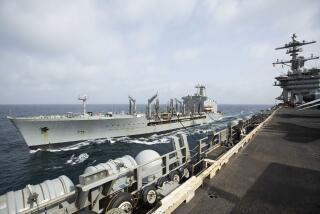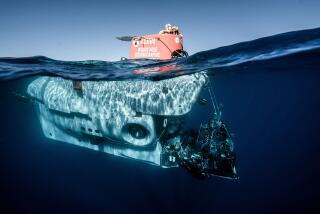Stricken Sub Towed Into Port
- Share via
SAN DIEGO — The research submarine Dolphin, damaged by fire and flooding, was towed into port Thursday amid concern that naval research projects might have to be curtailed if the one-of-a-kind ship is a total loss or needs lengthy repairs.
Navy officials had not yet opened the hatches to see how badly damaged the vessel is from a Wednesday morning incident in heavy seas 100 miles from San Diego. If the fire spread to the boat’s massive batteries, toxic chlorine could have spread quickly, posing a severe threat to sailors and the ship, officials said.
The 165-foot, 950-ton submarine was towed back to San Diego by a seagoing tug and escorted by the guided-missile frigate Thach.
Retired Vice Adm. Bernard Kauderer, former commander of the Pacific and Atlantic submarine fleets, said the loss of the Dolphin, even if only for a few months, could hurt numerous research projects.
Commissioned in 1968, the Dolphin, the Navy’s oldest and only diesel submarine, is used as a “platform” for innovations in sonar, acoustics, weaponry and communications as well as for undersea mapping.
The attack submarine fleet, reduced by nearly 50% since the end of the Cold War, is stretched too thin to allow one of its submarines to be converted for research, Kauderer said. Also, alone among Navy ships, submarines are dismantled when decommissioned. So there are no subs that can be pressed back into service.
“This will have a significant impact if we lose the Dolphin,” Kauderer said.
Tom Lapuza, spokesman for the Space and Naval Warfare System Command in San Diego, agreed with that assessment. “I can’t see us taking a submarine off war patrol to take over for the Dolphin,” he said. The fire broke out as the Dolphin was on the surface in 10-foot seas, participating in a multi-ship experiment involving torpedoes. Officials believe that seawater may have leaked into one of the top hatches, causing an electrical short.
Sailors fought the fire for nearly three hours before the ship’s skipper gave the rarely heard order to abandon ship about 2 a.m. “It’s the kind of thing you do in war, not in peacetime in the waters off your home port,” Kauderer said.
Forty-one sailors were evacuated from the submarine and two scientists were plucked from the choppy seas nearby. Dolphin crew members, wearing life jackets, were forced to jump into the water and swim toward the rescue boat launched by the Thach. If the boat had come too close to the submarine, it would have risked smashing into its side.
Two sailors were rescued by a Coast Guard helicopter as they began to drift away into the darkness. The other 41 crew members were pulled aboard the rescue boat and taken to the William McGaw, operated by the U.S. Geological Survey.
“Forty-three guys went into the water, and 43 guys got saved,” said Lt. Cmdr. Mark Ryan, pilot of the helicopter, which had been dispatched from San Diego shortly after midnight. “We’re all pretty stoked. This is not a scenario we train for much.”
More to Read
Sign up for Essential California
The most important California stories and recommendations in your inbox every morning.
You may occasionally receive promotional content from the Los Angeles Times.










